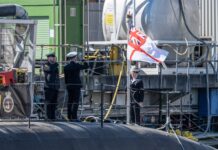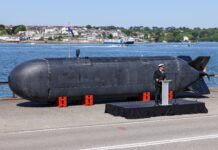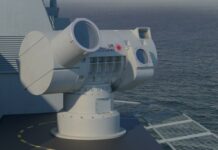
Royal Norwegian Navy chief points to wider co-operation from Type 26 deal
Dr Lee Willett
Norway’s selection of the UK as the strategic partner to provide its future frigate will open up other opportunities for further co-operation on capability development between the Royal Norwegian Navy (RNoN) and the UK Royal Navy (RN), the RNoN’s chief has told ESD.
On 31 August 2025 Norway announced the downselection of the UK’s BAE Systems-built Type 26 anti-submarine warfare (ASW)-focused frigate, with the aim of procuring at least five platforms to replace the RNoN’s four in-service Fridtjof Nansen-class vessels. Under the strategic partnership the ships will be built using a single, integrated, 13-hull production line: the five planned RNoN ships, plus the eight already on order for the RN.
Of the latter, five are already in build. As the two governments get to work on hammering out the details of the deal, one question to answer will be which ship already in build will be the first platform off the production line to be bound for Norway. As set out in its long-term defence plan, Norway has a standing requirement for its first new frigate to be in service by 2029-30. The RN’s first ship – the future HMS Glasgow – is in the water already and is set to be in service slightly ahead of that timeframe.
As the two navies will be operating the same ship in the same region to deter the same threat, the chief of the RNoN, Rear Admiral Oliver Berdal, explained to ESD that it also makes strategic, operational, procurement, technological and industrial sense to collaborate on other capabilities that will enhance the new frigates’ outputs collectively.
“You have to go beyond the Type 26 and the ships,” said Rear Adm Berdal. Uncrewed systems are an obvious step, both to bolster Type 26 capability and to deliver maritime effect elsewhere across the North Atlantic.

The RN’s new ‘Atlantic Bastion’ ASW concept, detailed in the UK’s Strategic Defence Review (SDR), published in June 2025, is being built around two phases: first ‘Atlantic Net’ and then ‘Atlantic Bastion’. The requirement for ‘Atlantic Net’ is to generate uncrewed sensing mass, especially using uncrewed underwater vehicles (UUVs). For ‘Atlantic Bastion’ such UUVs (and other uncrewed systems) will be integrated with crewed platforms, including the RN’s in-service Astute-class submarines and incoming Type 26 frigates. Speaking at the DSEI 2025 defence exposition in London in early September, the RN’s new First Sea Lord and Chief of the Naval Staff, General Sir Gwyn Jenkins, said his aim was to have the first ‘Atlantic Net’ UUVs in the water in 2026 and the first uncrewed surface vessels (USVs) designed to work in a surface action group with surface ships, like the inbound Type 26s, to be in the water in 2027.
Rear Adm Berdal and the RNoN are in lock step with this thinking.
“In general, the concepts are the same because these are concepts that we have already worked together on for a long time,” he said. “When we operate the same equipment, being able to deepen the co-operation … is much easier than when we operate ships that are grey, but the inside and outside are totally different.”
As regards working together on uncrewed capability innovation and integration, “We have to be forward leaning when it comes to that,” said Rear Adm Berdal. Crewed aircraft are moving towards integrating with uncrewed aircraft in ‘loyal wingman’ concepts in the air domain, while in the maritime domain things are moving in the same way. This means Norway and the UK should be looking at uncrewed capabilities that can operate alongside the Type 26s and alongside P-8 Poseidon maritime patrol aircraft, which both the UK and Norway operate, the admiral added.
For the Type 26 such integrated, supporting presence provided by uncrewed systems could be harnessed in each of the air, surface, and sub-surface domains.
Rear Adm Berdal also explained that the way uncrewed systems might develop in capability and scale may mean the two navies will see the need to evolve how they think about using their future frigates. While the Type 26 is primarily an ASW platform, it also has significant multirole capacity. “Moving a few years into the future, as these ships really start coming online in numbers, that multirole capacity is probably going to be the area that we really need to succeed with, and especially using the Type 26 to a certain extent almost like a mothership for some of the uncrewed technology that will augment the frigate’s operations in the future,” the admiral explained. In the medium term – over the next five to 10 years – frigates and other major platforms are likely to be supported in all domains by uncrewed systems, particularly to increase maritime situational awareness and ship self-defence, he continued: “So, whether that is uncrewed technology in the air, on the surface, or sub-surface, in the future we will end up with major surface ships playing more of a mothership role for the uncrewed units supporting them. That’s where I see things are moving,” he said.
Industrial integration
To enable these future conceptual developments using uncrewed systems, Rear Adm Berdal highlighted the importance of developing an integrated industrial approach, including through focusing on areas of speciality.
Collaboration – including to avoid duplication – on the innovation cycle for uncrewed systems is crucial, especially with the two navies operating in the same area. “It does not necessarily make sense to end up with a lot of different variants of homegrown systems, so we must utilise, and capitalise on, the inherent strengths of both the British and Norwegian defence technological and industrial bases,” said Rear Adm Berdal.
“When it comes to sub-surface and seabed uncrewed systems, that’s an area where Norwegian companies are at the forefront, including on a global scale,” the admiral explained. This expertise derives from advances in the commercial oil and gas field and underpins Norway’s leading role in dealing with critical undersea infrastructure (CUI) threats in the North Atlantic.
The UK has many promising initiatives in many different areas, too, Rear Adm Berdal noted. “So we have to look at the strengths of both countries and try to maximize which areas we push forward,” he said.
“Everything related to uncrewed systems – USVs, UUVs or seabed systems, whenever they are ready to be militarised – are areas where we have to go hand-in-hand, shoulder-to-shoulder, to ensure we can fully develop the concept in question for ASW, but also for anti-surface warfare and ship self-defence,” the admiral concluded.






![Hybrid navies: Integrating uncrewed capability into carrier strike The US Navy (USN) carrier USS John C Stennis (left), the French Navy carrier FS Charles de Gaulle, and elements of their strike groups are pictured sailing together in US Fifth Fleet’s area of operations. The US, French, and UK navies are all developing ‘hybrid’ crewed/uncrewed mixes for their carrier airwing capability. [US Navy]](https://euro-sd.com/wp-content/uploads/2025/09/2-HST-CdG-USN-Kopie-218x150.jpg)






